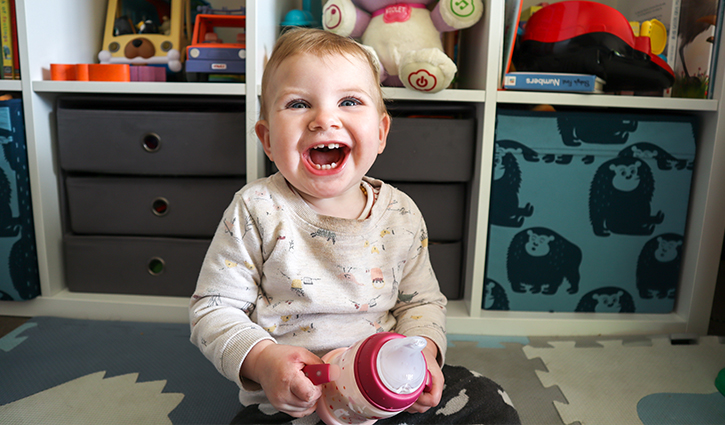

Just when you’ve got the hang of bottle feeding your baby, and maybe you’re even starting to find your groove as a parent…BAM! Something else pops up to rock your world as they head into toddlerhood.
Around their first birthday, it’s recommended that you transition from bottles of milk (as it’s no longer your baby’s main source of nutrition) to cups of full-fat dairy or non-dairy milk, breastmilk (which is still a valuable source of nutrition for toddlers), or water.
Remember, the World Health Organisation recommends continued breastfeeding combined with solid foods for 2 years, or for as long as mother and baby desire.
Here we explore when to start, why it’s necessary, and how to transition your toddler from a bottle to a sippy cup or open cup.
The transition from bottle feeding to sippy cup or open cup
Some babies take to a sippy cup or open cup easily, while others like to cling to their bottles for years. You’re probably already aware of the health repercussions from bottle-feeding for too long (more on that below), but what if your little one isn’t onboard with drinking from anything but their precious bottle?
If bottles help to lull your little person to a lovely, drowsy state before naps and bedtime, you’re probably not too keen to give up that comforting tool. But don’t worry, there is a way to wean your baby off the bottle gently and kindly, and still support their sleep.
When to start?
It’s a good idea to introduce a learner bottle, sippy cup, or open cup of water when your bub starts solid foods. They may not drink much or even any water in the beginning, but it’s simply to get them familiar with it.
Using a cup with handles means that your baby can learn to drink independently, which will help to create a positive association with mealtimes. Babies and toddlers love the opportunity to do things for themselves (which you may have already discovered!).
If your baby is older, or is past their first birthday, it can be difficult to break the attachment to the bottle. If you know toddlers, you’ll be only too aware that they start to form their own strong opinions.
What are the reasons to transition from bottles at 12 months?
- Tooth decay (particularly if teeth aren’t brushed after the bedtime bottle, the milk can pool up on the teeth overnight).
- Picky eating (they might have a preference for their milk instead of certain foods).
- Potential nutritional deficiencies (if they’re filling up on milk instead of solids, they could be missing out on important nutrients, plus cow’s milk can block the absorption of iron).
- Misaligned teeth (prolonged sucking on bottles can affect the development of their oral muscles, which could impact their teeth and jaw alignment).
- Obesity (toddlers tend to drink more milk from a bottle than a cup).
Simple steps to transition from the bottle
It doesn’t have to be a stressful process. You may have heard of some families going cold turkey with bottles, but this could potentially cause a lot of unnecessary upset to everyone. The key is to take it slow, be kind, and patient. It’s not the end of the world if your toddler loves their bottle!
1. Start early
Introduce your baby to your cup of choice, even just to play with it at first. Offer it at mealtimes with cooled boiled water when they start solids.
2. Time it right
It’s a good idea to start the process when there’s nothing stressful going on, such as the start of daycare, a move, a holiday, or the birth of a new sibling.
3. Let them be involved
Make it a special event, and take them to the shops to choose their cup. Look for ones with easy grip training handles.
4. Start with a silicone spout
A soft silicone spout will feel similar to a bottle’s teat, so it might make the transition easier.
5. Offer it instead of a bottle
Once your bub is familiar with and has mastered the learner bottle or sippy cup with water, you could slowly start to replace some of their regular bottles with a cup of their formula or breastmilk.
6. Eliminate gradually
Start replacing one bottle a day with an open cup or sippy cup, and then after a few days, reduce the amount at each feed. You might like to save the morning and bedtime bottle until last. It’s not a race, so only move on when your child is comfortable.
7. Have a comfort replacement
If your toddler’s bottle has become a true comforting measure, particularly at bedtime, then you could introduce a new comfort item during bottle feeds to create a new positive sleep association. This could be a blanket, teddy, doll, and of course, offer plenty of cuddles and reassurance.
8. Reduce the bedtime bottle
When you’ve replaced all of their bottles with cups, you can gradually reduce the volume of their nighttime bottle (which will now be a cup). To further break the association between milk and bedtime, you might decide to offer the milk in another room before heading to their bedroom for a story and cuddle. Their new comforting item will take the place of the bottle.
9. Ditch the bottles altogether around 12 months
After their first birthday, it will get harder to wean them off the bottle as their attachments to comforting items become stronger. Get the bottles out of the house once your toddler has transitioned to the next stage. Out of sight, out of mind!
Just remember though, it is your decision and your child. Follow their lead, and slow down if it becomes distressing for them.























